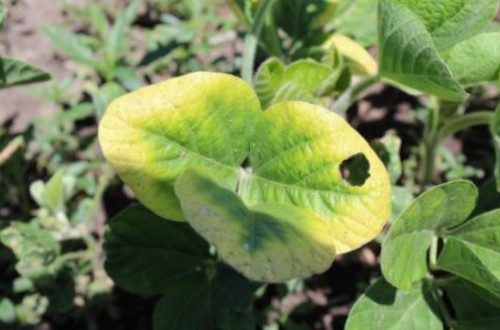By Ashley Dean
This year we have received many inquiries about potato leafhopper (Photo 1) in soybean and alfalfa. Although they are present in Iowa every year, populations are higher than in 2018 and 2019. Usually, potato leafhoppers are only considered a pest of alfalfa in Iowa, but they do feed on soybean, too. Potato leafhoppers prefer smooth leaves and are usually repelled by varieties with pubescence (hairs).
Photo 1. Potato leafhopper adult (top) and nymph (bottom). Photo courtesy of Penn State College of Agricultural Sciences.
In soybean, potato leafhopper nymphs can be mistaken for soybean aphid because they are similar in size and color. These hoppers have white eyes, tapered abdomens and do not have cornicles (Photo 1). Potato leafhoppers inject a toxic saliva into the plant while feeding with a piercing-sucking stylet. This style of feeding destroys plant cells and inhibits the transport of fluids within leaves. In soybean, potato leafhoppers feed along the mid-veins, causing the leaf to curl or twist. In severe cases, soybean and alfalfa can exhibit “hopper burn” (Photo 2). Feeding injury creates stunted plants with leaves that turn yellow along the margins and may eventually fall off. Soybean usually outgrows symptoms of hopper burn, but new alfalfa stands and regrowth following cutting may be severely affected. Since hopper burn in soybean can be similar to potassium deficiency, it is important to scout to confirm the presence of potato leafhopper.

Photo 2. Potato leafhopper feeding is known as “hopper burn.” Note the characteristic v-shaped yellowing along the margins of the leaves (ignore hole). Photo by Rebecca Vittetoe.
While walking through soybean, hoppers are easily disturbed and will attempt to hop or fly away from you. We recommend using a sweep net to estimate the number of potato leafhoppers per sweep and assess population changes over the growing season. Treatment options in alfalfa are based on stand size, market value, and hopper density. See
this ICM News article for an economic threshold table. No such thresholds exist for potato leafhoppers in soybean.
Typically, potato leafhopper injury is not enough to warrant an insecticide treatment in soybean. Field evaluations have only been able to document yield loss from this pest when heavy infestations cause severe stunting on very young plants. However, when heavy infestations occur, plants are more susceptible to severe injury when:
- Planting is delayed into June and soybean is still in the early vegetative stages
- Variety has smooth leaves or has little pubescence
- Drought conditions occur
We do not typically recommend treating soybean for potato leafhoppers alone. The exception is if severe hopper burn is present AND plants are under additional stress, such as drought. In these cases, many foliar insecticides are labelled for use against potato leafhopper in soybean. The greatest concern for soybean and alfalfa growers in Iowa at this point in the season is potato leafhopper injury combined with dry conditions. According to the U.S. Drought Monitor, 7% of Iowa is in a moderate drought and 42% of Iowa is abnormally dry (Figure 1).
Figure 1. The western half and the eastern “nose” of Iowa are abnormally dry. Data courtesy of the United States Drought Monitor (droughtmonitor.unl.edu).
Make sure to scout for potato leafhopper while dry conditions persist to minimize their impact. Adults and nymphs can be managed with pyrethroid insecticides, but exercise caution when applying pyrethroids in areas where soybean aphid is present. Some soybean aphid populations have evolved resistance to pyrethroid insecticides. Check the insecticide label and follow all labelled rates to ensure effective management.
Source : iastate.edu